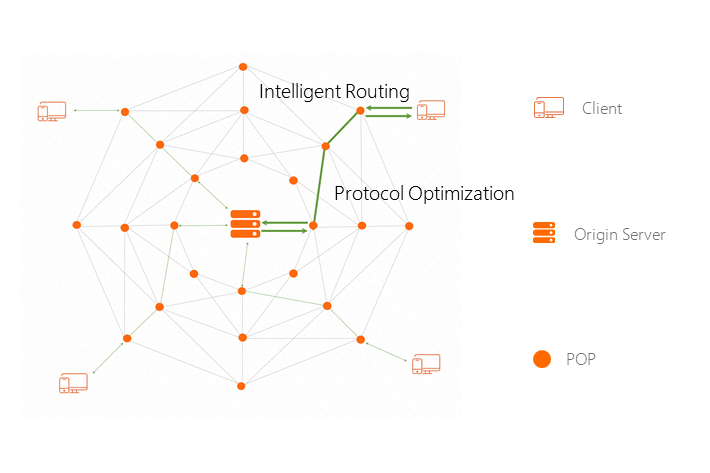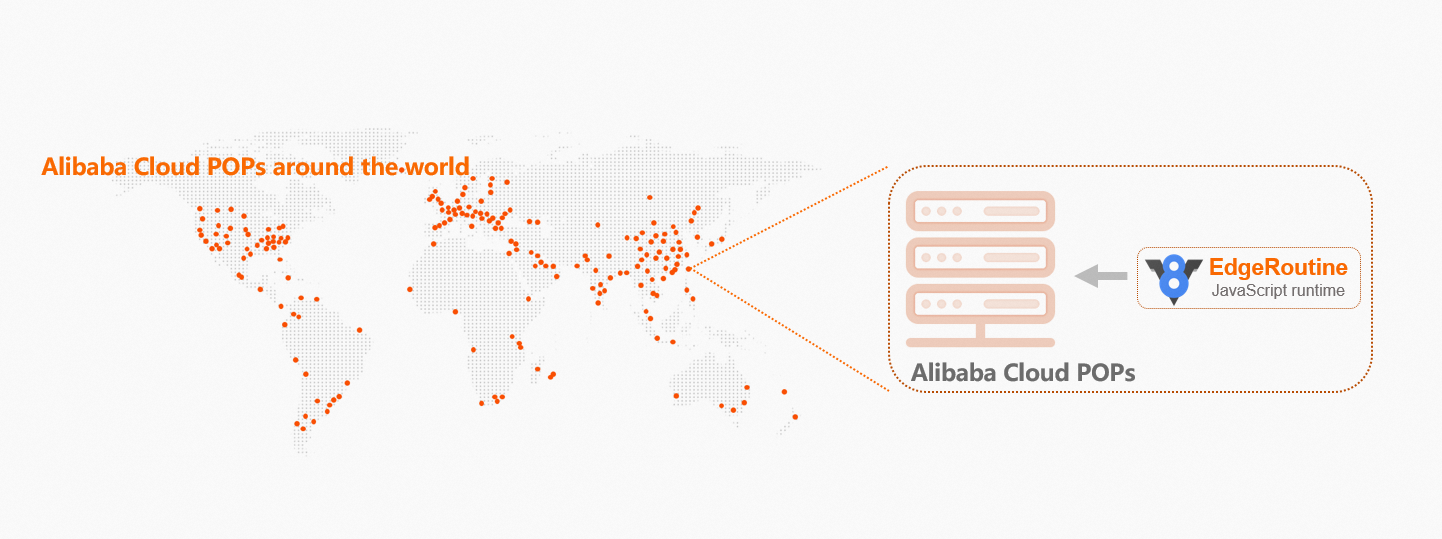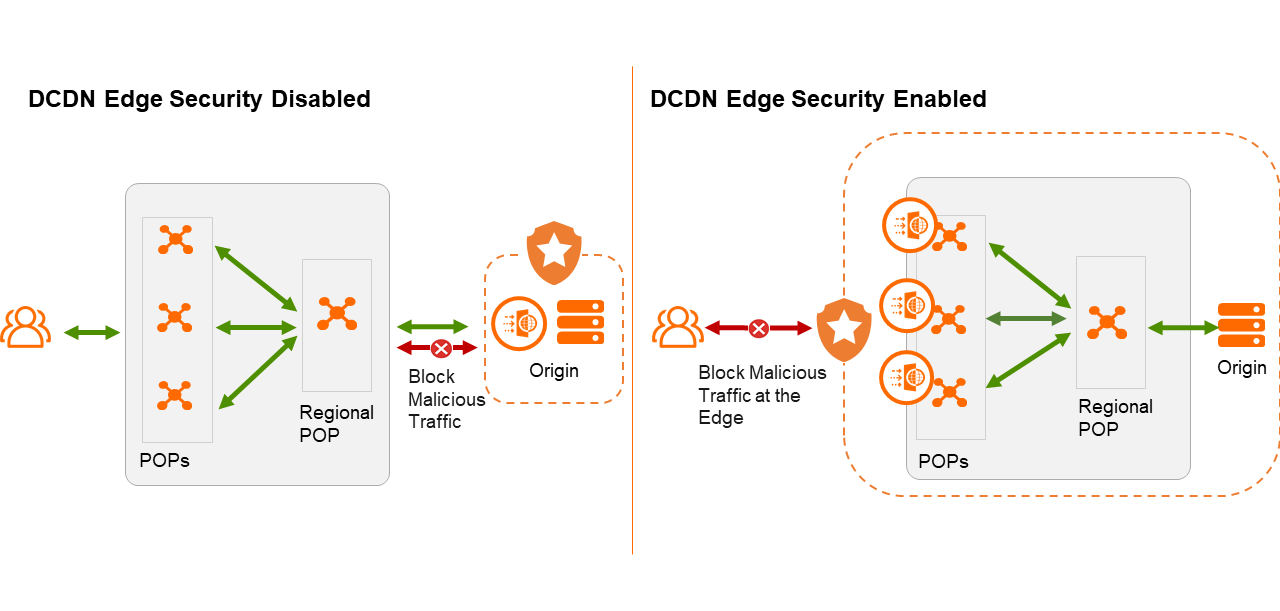With the advancement of online business, more and more services serve customers around the world. This phenomenon has introduced large and complex challenges to user experience and business security. Dynamic Content Delivery Network (DCDN) is Alibaba Cloud's solution to these challenges, a global network that not only distributes and accelerates content delivery, but also provides security and computing capabilities at the edge.
Nearby access accelerates the distribution of dynamic and static content
As online services grow, so does their user base around the world. This introduces challenges such as longer transmission distances, differences in network quality between regions, and network congestion. These issues may cause websites or applications to slow down or time out, affecting user experience.
DCDN minimizes content delivery latency, providing your users with faster and more responsive services, and improving user experience. This is a key factor in customer conversion and stickiness.
Bring your content closer to your customers
DCDN caches static content, such as images and videos, on more than 3,200 globally distributed POPs. User requests are served up from the POP closest to them, speeding up content delivery and reducing load times.
Intelligent routing for dynamic content
DCDN helps improve the performance of delivering non-cacheable, dynamic content through a series of intelligent routing enhancements. When DCDN receives requests for dynamic data such as APIs, IoT telemetry data, or real-time signals for online games, it calculates the best route over which to serve the requests. DCDN does this by evaluating the real-time network quality information of its global network spanning over 3,200 POPs, avoiding transient, congested, or lossy routes.
For more information about static and dynamic content, see What are static content and dynamic content?
Support for a wide range of transmission protocols
DCDN supports HTTP, HTTPS, Layer 7 acceleration based on WebSocket, and IP Application Accelerator (IPA) based on TCP and UDP. Additionally, DCDN makes on-the-fly optimizations to acceleration policies to ensure that your content is delivered over the most efficient transmission routes.
Accelerate virtually anything
You can use DCDN for virtually any kind of service delivered over the Internet. After your origin server is connected to DCDN, your content is delivered over a secure network with low latency and high transfer speeds. For more information about the acceleration performance of DCDN, see DCDN synthetic monitoring data.

Unleash your innovations with edge computing
As Internet services become more complex and diversified, dynamic requests become more common. Personalized and tailored services such as search results and personalized recommendations are a major driver in why most of today's traffic is made up of dynamic requests. However, serving personalized content requires some computing, which places a fair amount of load on your origin and increases request round-trip time.
You can use DCDN to offload computing jobs to POPs, relieving the load on your origin. Since DCDN helps run your computing jobs, you also benefit from better service availability and reduced bandwidth costs. These capabilities are made possible through DCDN's edge computing services, which let you run custom code on any DCDN POP all around the world and better serve your users.
Global presence with ultra-low latency
DCDN places your code globally at POPs close to your users, shortening the distance requests need to travel by more than 50%. Incoming requests are handled at the POPs, significantly reducing the response time and helping you deliver a more responsive user experience.
Serverless: effortless, yet powerful
After you upload your code to DCDN, our serverless architecture takes over and manages the computing and storage resources.
DCDN takes care of all the hard parts, including distributing your code to POPs all around the world, routing and load balancing requests. In short, you no longer need to manage any resources or plan for availability, but instead focus on improving the performance and efficiency of your code.
Instantaneous, elastic scaling
When the number of client requests in a region suddenly increases, DCDN spins up computing resources located in close proximity to the request origins, scaling your code and routing requests to ensure services are delivered without any hiccups.

End-to-end protection against attacks and intrusions
As more systems and services are digitized and moved online, they become potential attack targets. Malicious actors may try to gain access to these systems and steal information, and victims of successful attacks often have to deal with the fallout, including the risk of lost customers, revenue, and brand confidence.
DCDN provides integrated security services on POPs to filter and intercept malicious traffic close to the source of requests. You can enable edge protection in just a few simple steps to protect your websites, APIs, and applications.
End-to-end data protection
DCDN provides comprehensive and reliable security protection for your data. You can configure features such as SSL certificates, referer-based hotlink protection, URL signing, and bot traffic management to defend against network attacks and ensure data security. For more information, see Enable edge security.
WAF protection
You can enable Web Application Firewall (WAF) on POPs to identify and scrub malicious traffic, and route the scrubbed traffic to the origin server. Edge WAF supports IP whitelist and blacklist, region blacklist, bot management, and custom policies to implement fine-grained access control and rate limiting. For more information, see Overview of WAF (new version).
DDoS mitigation
DCDN integrates DDoS mitigation into POPs. When a DDoS attack is detected, the system automatically switches traffic from the acceleration service to the DDoS mitigation service. After the attack ends, the system automatically switches the scrubbed traffic to the acceleration service. DCDN can intelligently identify Layer 3, Layer 4, and Layer 7 DDoS attacks. The total protection bandwidth of all POPs reaches the Tbit/s level. For more information, see Mitigation settings.
